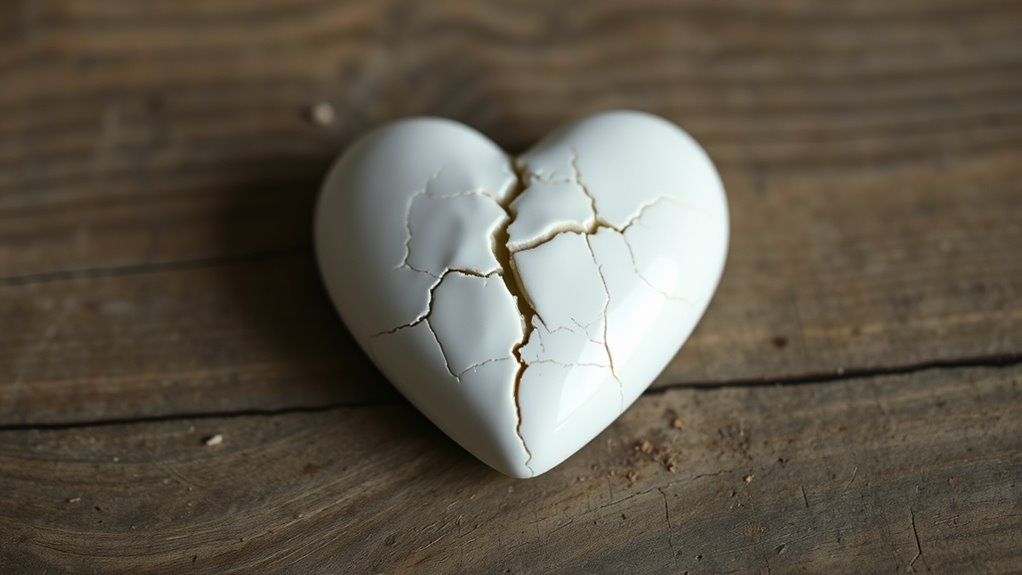Healing your anxious heart after a breakup begins by recognizing how your attachment style influences your pain. You might cling to memories or seek reassurance, which can prolong emotional wounds. Building resilience through self-compassion, mindfulness, and setting boundaries helps you process feelings more effectively. Patience and awareness are key; as you actively tend to your emotional health, you’ll gradually reclaim your sense of security. Continue exploring ways to nurture yourself and transform heartbreak into growth.
Key Takeaways
- Recognize how attachment style influences emotional reactions to breakup and tailor healing strategies accordingly.
- Practice mindfulness and self-compassion to soothe anxious feelings and reduce dependency on reassurance.
- Allow yourself to sit with pain patiently, avoiding impulsive reassurance-seeking or rumination.
- Use journaling and therapy to reframe negative thoughts and rebuild a secure personal narrative.
- Cultivate resilience through self-care, setting boundaries, and trusting the healing process over time.

Breaking up from someone you care about can leave deep emotional scars that linger long after the relationship ends. These wounds often stem from the complex interplay of your attachment style and your emotional resilience. When a relationship ends, especially if you have an anxious attachment style, you might find yourself overwhelmed by feelings of abandonment, betrayal, or intense longing. Understanding your attachment style is vital because it shapes how you respond to loss and heartbreak. If you tend to be anxiously attached, you probably seek constant reassurance and fear being left alone, which can intensify the pain of a breakup. Recognizing this pattern allows you to start addressing it consciously, rather than letting it control your emotional landscape.
Understanding your attachment style helps you manage heartbreak and foster emotional resilience after a breakup.
Building emotional resilience becomes your most powerful tool in healing. It involves strengthening your capacity to recover from emotional setbacks and maintain a sense of stability despite the pain. You can develop resilience by practicing self-compassion, setting healthy boundaries, and engaging in activities that reinforce your sense of identity outside the relationship. It’s about learning to sit with discomfort without letting it consume you, which gradually diminishes the power of these painful emotions over time. Resilience doesn’t mean ignoring your feelings; it’s about acknowledging them and choosing to nurture yourself through the process. Incorporating practices like mindfulness techniques can help you stay present with your emotions without becoming overwhelmed.
Your attachment style influences how quickly you bounce back from heartbreak but also how deeply you feel the pain. If you have an anxious attachment, the fear of being alone can make you cling to memories or seek reassurance from others prematurely. This can trap you in a cycle of emotional dependency, making it harder to move on. Recognizing these tendencies helps you create healthier coping strategies, such as journaling your feelings, practicing mindfulness, or seeking support from a therapist familiar with attachment theory. These approaches help you reframe your narrative, reducing feelings of inadequacy or fear of abandonment that often accompany break-up wounds.
Healing requires patience and self-awareness. The more you understand your attachment style and actively work on building emotional resilience, the more empowered you become in your recovery. Remember, emotional scars may fade with time, but they won’t disappear unless you actively tend to them. Each step you take—whether it’s accepting your feelings, seeking support, or practicing self-care—brings you closer to reclaiming your sense of security and inner peace. Over time, the pain diminishes, and you learn to trust yourself again, transforming break-up wounds into opportunities for growth and self-discovery.
Frequently Asked Questions
How Long Does It Typically Take to Heal Attachment Wounds?
Healing attachment wounds varies for each person, often taking months or even years. It depends on your emotional resilience and understanding of your attachment style. If you actively work on processing emotions and building healthy patterns, you’ll likely heal faster. Be patient and gentle with yourself, knowing that progress isn’t linear. With time, effort, and support, you’ll find your way toward emotional balance and stronger, healthier relationships.
Can Attachment Wounds Affect Future Relationships?
Imagine you’re in a vintage movie, and yes, attachment wounds can definitely affect your future relationships. These wounds influence your emotional resilience and trust rebuilding. If left unhealed, they might cause you to doubt love or fear abandonment again. Recognizing this allows you to work through your pain, build healthier patterns, and foster trust. With patience, you can create stronger relationships, even after past heartbreaks.
Are There Specific Therapy Techniques for Attachment Healing?
You can heal attachment wounds using specific therapy techniques like mindful techniques and emotion regulation. These methods help you become aware of your feelings without judgment, allowing you to process emotions healthily. By practicing mindfulness, you learn to stay present and reduce anxiety, while emotion regulation strategies help you manage intense feelings. Together, these techniques support healing attachment wounds, fostering healthier relationships and a more secure sense of self.
How Do Attachment Wounds Differ From General Heartbreak?
Attachment wounds differ from general heartbreak because they stem from deep-seated attachment styles formed early in life, affecting your emotional resilience. While heartbreak often involves immediate pain from loss, attachment wounds involve ongoing fears of abandonment or rejection that shape your relationships. Healing requires addressing these underlying attachment patterns, strengthening your emotional resilience, and fostering secure connections, which go beyond typical heartbreak recovery.
Is It Possible to Fully Recover From Attachment Wounds?
You can absolutely work towards healing your attachment wounds, but complete recovery varies for each person. Developing emotional resilience is key, allowing you to process pain and rebuild trust. The healing process involves understanding your wounds, practicing self-compassion, and seeking support if needed. While some scars might remain, over time, you’ll find yourself more secure and confident in future relationships. Healing is possible with patience and effort.
Conclusion
As you heal these attachment wounds, remember that even Pandora’s box held hope. Like the phoenix rising from ashes, your anxious heart can transform through patience and self-compassion. Embrace this journey as a gentle reminder that you’re crafting a new chapter—one where love begins within. Trust that, with time, you’ll find your own melody, echoing softly like a whisper in the wind, guiding you toward wholeness and peace.










